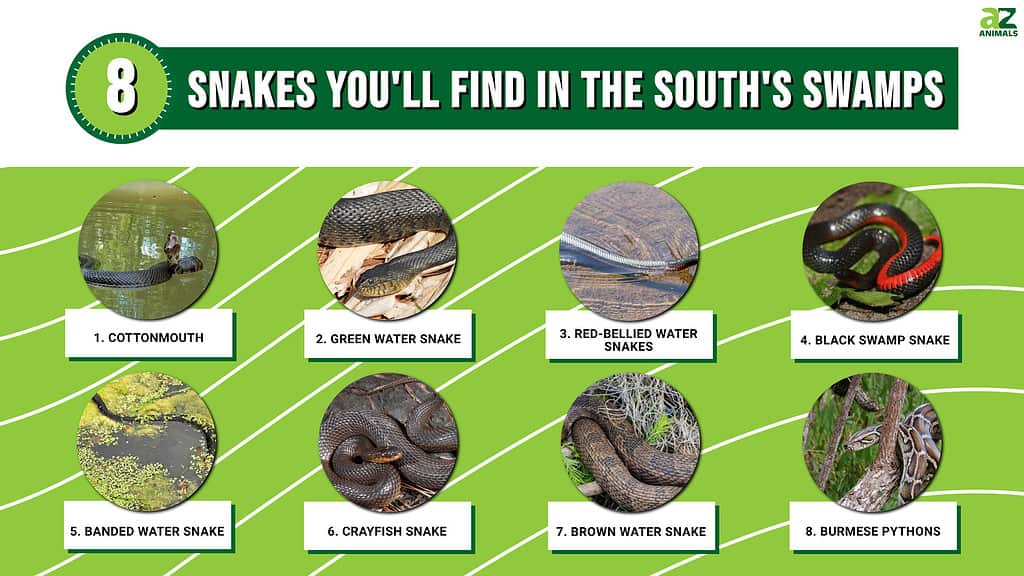
Of all the snakes you’ll find in the South’s swamps, only one is venomous. Most of the South’s swamp snakes are small and harmless, but one invasive species is so big that it can kill and swallow a deer whole. Snakes live in all manner of habitats all over the world, and they’re most common in warm areas. Rattlesnakes and rat snakes prefer dry, warm areas, whereas water-loving snakes love swampy habitats.
Here, we’ll discover eight snakes common to the swamps of the South. We’ll learn what each species looks like and whether or not they’re dangerous. Then, we’ll discover what they eat and what parts of the South they inhabit.
Read on to learn more about the eight snakes you’ll find in the South’s swamps!
8. Burmese Python
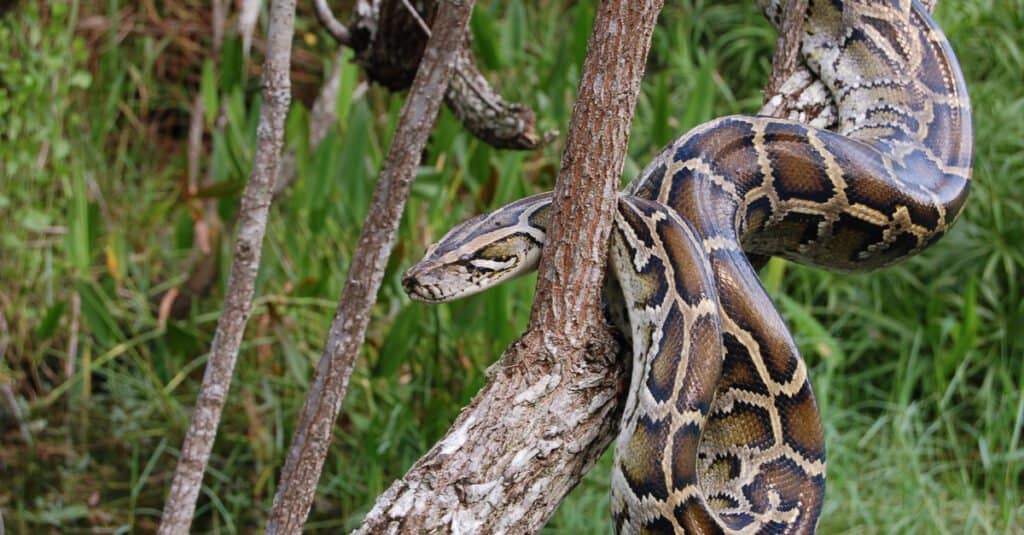
The
Burmese
python’s scientific name is Python bivittatus.
©Heiko Kiera/Shutterstock.com
Unlike the other snakes on our list, the Burmese python is not native to the South or even to North America. These snakes live in the Florida Everglades. In the 1980s, a few people released their pet Burmese pythons into the swamps. Today, there are thousands of invasive Burmese pythons in the Everglades. Unfortunately, they eat everything in sight, which has led to a massive species die-off in the Everglades.
Burmese pythons grow up to 15 feet long and kill by constricting their prey. They eat everything from foxes, rabbits, and raccoons to alligators, birds, and deer. They’re easily recognized by their large size and intricate, blotched brown on tan pattern.
7. Brown Water Snake
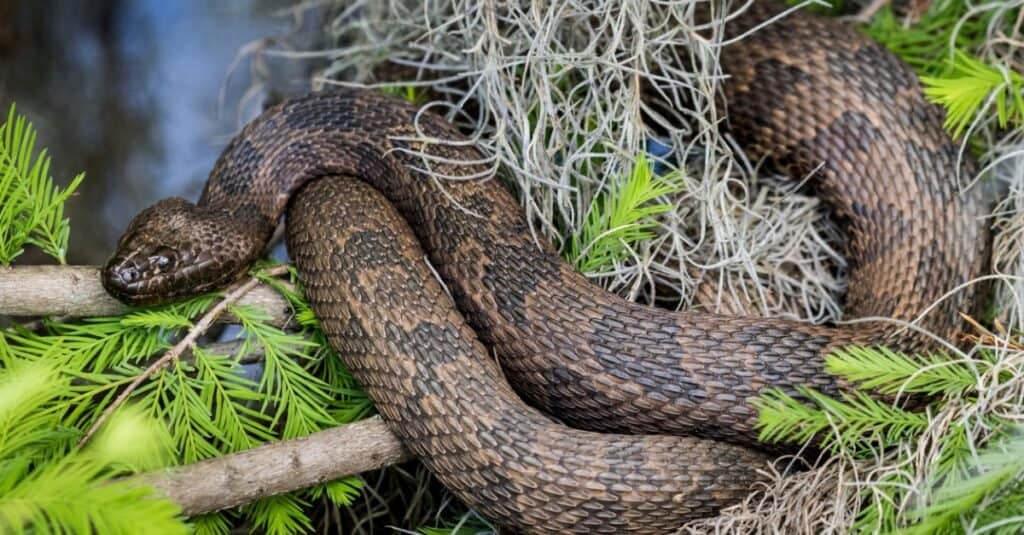
The brown water snake’s scientific name is Nerodia taxispilota.
©iStock.com/csraphotography
When it comes to snakes you’ll find in the South’s swamps, there are few larger than brown water snakes. These snakes grow up to five feet long and have heavy bodies. They’re all over brown, with darker blotches on their sides and back. Brown water snakes have short heads with round pupils. They live in all coastal areas of the South, including the Florida panhandle, and can be found as far north as Virginia. Brown water snakes are not venomous, but they are quick to bite in self-defense. Unfortunately, they’re often mistaken for cottonmouths and killed by fear-driven humans.
6. Crayfish Snake
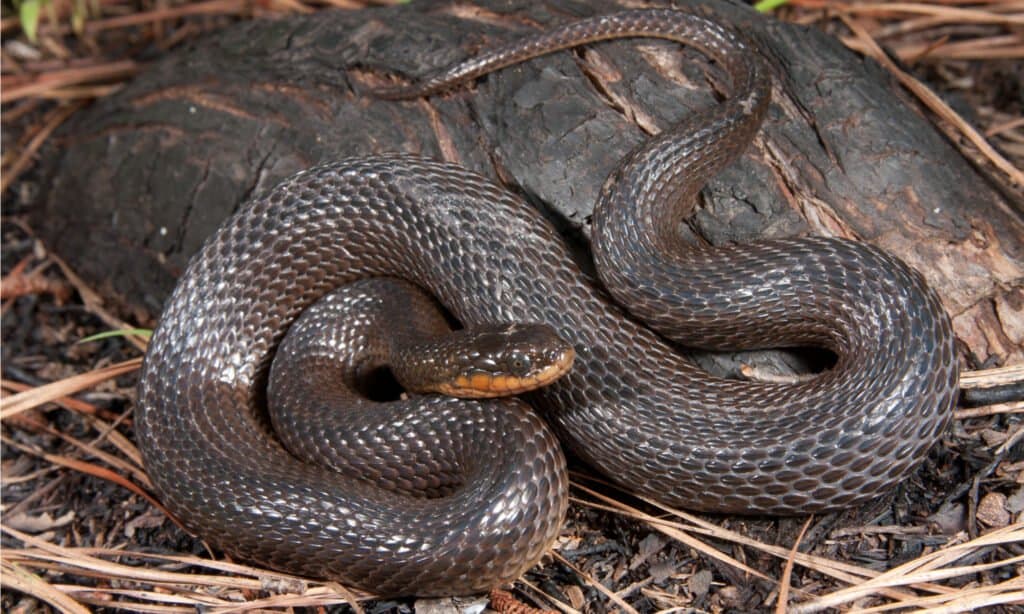
The crayfish snake’s scientific name is Liodytes rigida.
©Nathan A Shepard/Shutterstock.com
Crayfish snakes go by many names, including striped water snakes, glossy water snakes, glossy swamp snakes, and glossy crayfish snakes. It should come as no surprise that these snakes have a glossy appearance. Their backs and sides are medium brown and unpatterned, but their undersides have alternating tan and dark brown scales. They have narrow heads and relatively heavy bodies, though they only grow to just over a foot long. Crayfish snakes eat mostly crayfish. They live in the coastal areas of the South as far west as Texas and as far north as Virginia.
5. Banded Water Snake
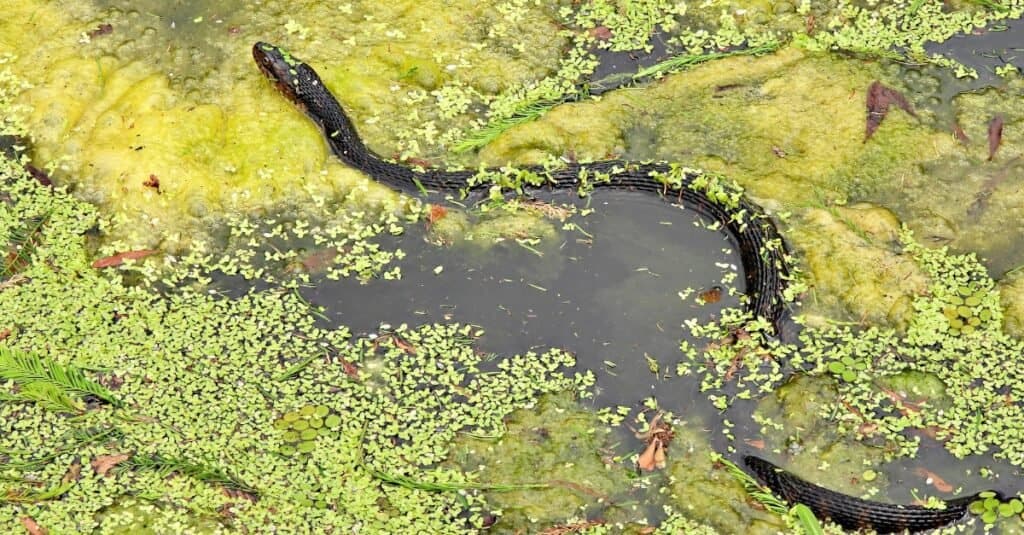
The banded water snake’s scientific name is Nerodia fasciata.
©iStock.com/passion4nature
Among the snakes you’ll find in the South’s swamps, banded water snakes are among the most common; at least in the coastal parts of the southeast as far north as North Carolina. These snakes grow up to four feet long and have relatively heavy bodies. They range from brown with darker blotches to orange with red blotches.
Banded water snakes bear a superficial resemblance to cottonmouths, though they lack white mouths or triangular heads. These snakes eat fish and amphibians almost exclusively. They’re commonly seen sunbathing on branches overhanging the water or on logs or rocks near the water’s edge.
4. Black Swamp Snake
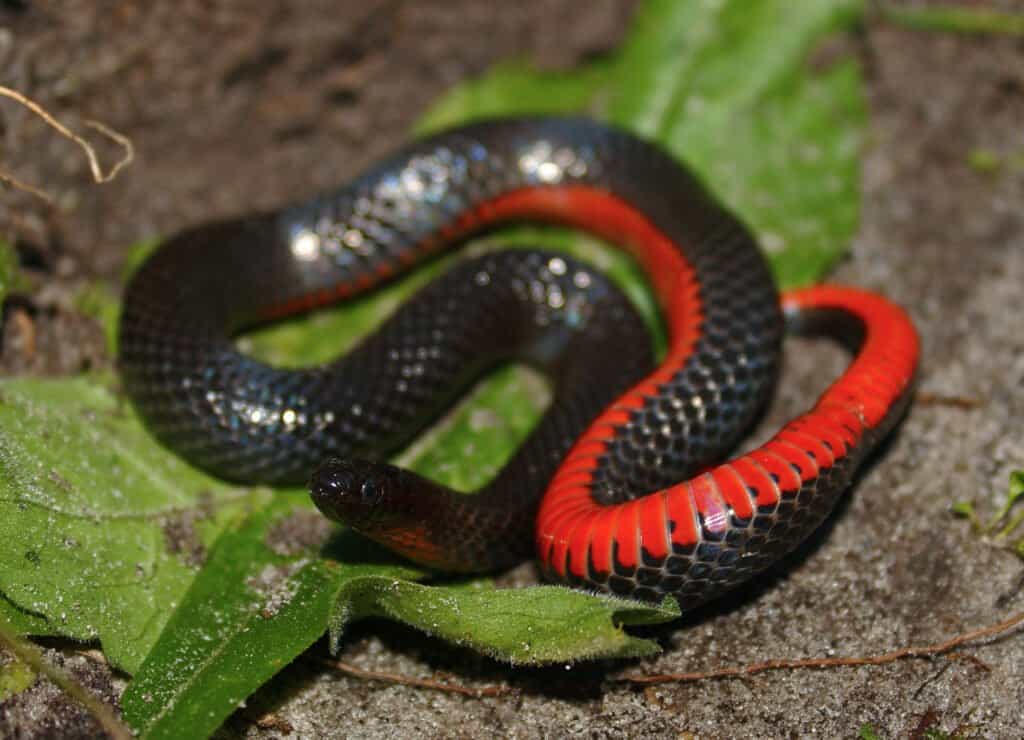
The black swamp snake’s scientific name is Seminatrix pygaea.
Black swamp snakes have striking appearances. Their backs and sides are glossy black, while their bellies are bright red. These snakes only grow to about two feet long and spend most of their time in the water. They live only in the coastal southeast, including the Florida panhandle. Since black swamp snakes are small and very secretive, people rarely see them. But, they hunt both at night and during the day. Black swamp snakes eat frogs, tadpoles, small fish, salamanders, and leeches.
3. Red-bellied Water Snake
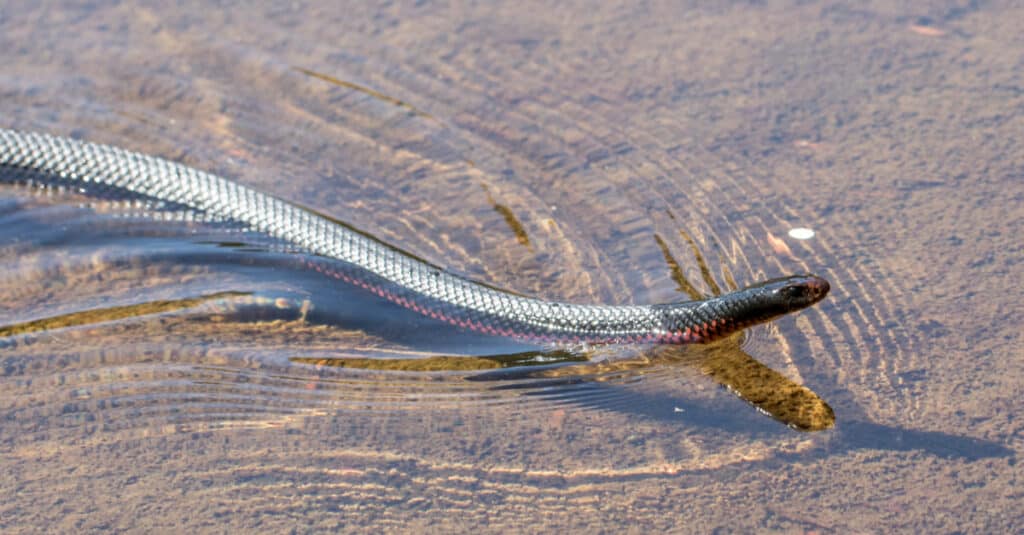
The red-bellied water snake’s scientific name is Nerodia erythrogaster.
©Ken Griffiths/Shutterstock.com
Out of all the snakes you’ll find in the South’s swamps, the red-bellied water snake just might have the brightest belly. Red-bellied water snakes are named for their bright orange or red, unpatterned undersides. Their sides and backs are dull gray to black, and they have small heads with round pupils. They grow up to four feet long and live throughout the southeast, but not in the Florida panhandle. These snakes primarily eat frogs, toads, salamanders, and fish.
2. Green Water Snake
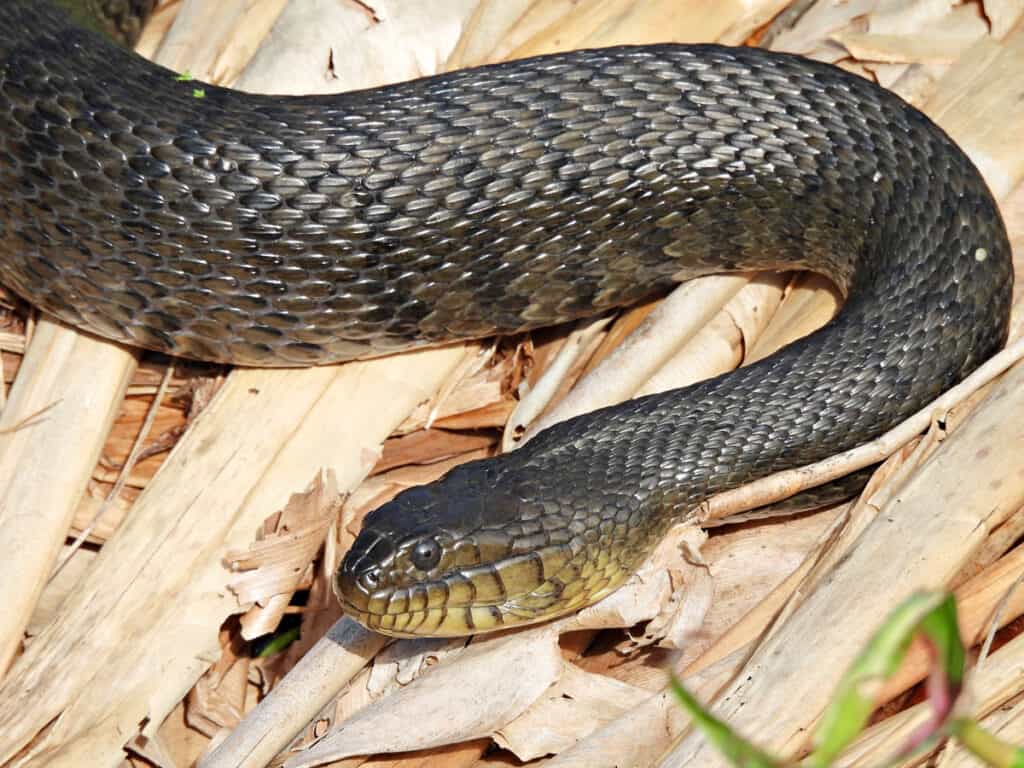
The green water snake’s scientific name is Nerodia floridana.
©iStock.com/passion4nature
Green water snakes have the distinction of being the largest water snakes in North America. They grow up to 55 inches long (about 5.5 feet) and live only in the Florida panhandle and some parts of Georgia and South Carolina. Their undersides are light tan to white, with green to brown sides and back. Green water snakes live in swamps thick with vegetation, as well as slow-moving rivers, lakes, and marshlands.
1. Cottonmouth
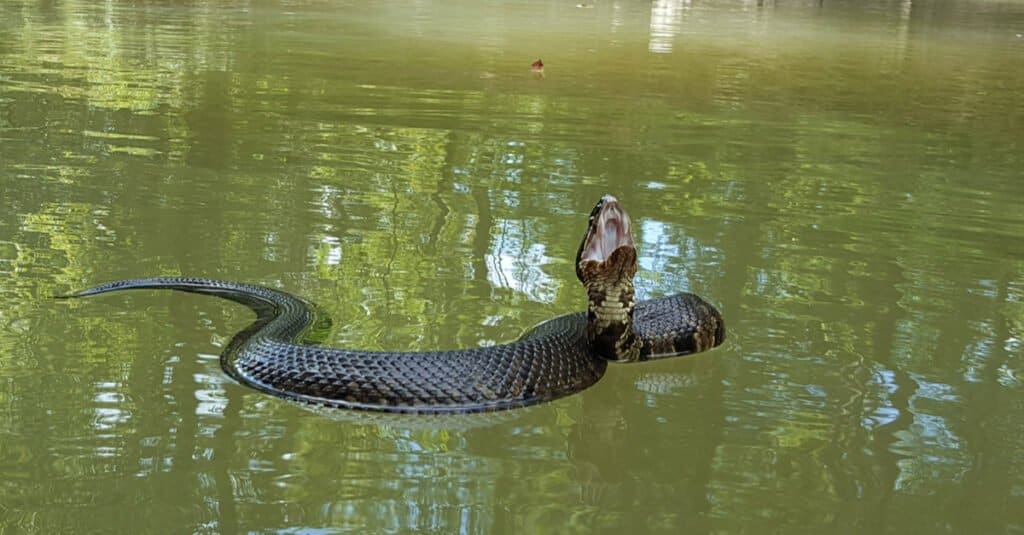
The cottonmouth’s scientific name is Agkistrodon contortrix.
©Seth LaGrange/Shutterstock.com
Cottonmouths are among the most interesting snakes you’ll find in the South’s swamps. When threatened, they coil into a tight ball with their head upright in the center. Then, they open their mouths and hiss, displaying the cottony white interior of their mouth. Cottonmouths are pit vipers, like adders and rattlesnakes, and possess large fangs, venom glands, and heat-sensing pits. They have triangular heads and vertically elliptical pupils.
Cottonmouths live throughout the swampy areas of the South. They eat turtles, alligators, birds, lizards, snakes, fish, and amphibians. Instead of constricting, cottonmouths kill their prey with deadly venom. If you encounter a cottonmouth, do not approach it. And, if you sustain a bite from one, seek immediate medical attention.
Other Swamp Animals in the South

The African Clawed Frog is known for being especially adaptable and voracious
The African Clawed Frog: An especially voracious amphibian, this frog is capable of producing prolifically and surviving environmental extremes of cold, heat, and salinity. It is also capable of crossing vast areas of land in the company of its relatives and is capable of taking on larger prey thanks to its clawed feet.
The invasive species has also spread to Arizona, California, Colorado, Massachusetts, Milwaukee, North Carolina, Virginia, and Washington and all over the globe. Several states in the United States prohibit ownership of the clawed amphibian as a pet.
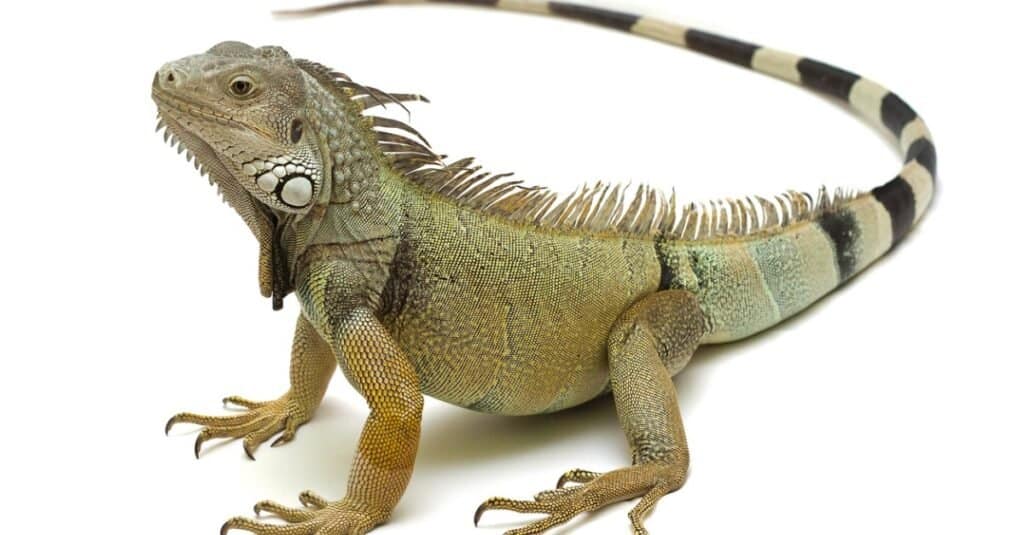
Green Iguanas are especially fond of shoots, fruit, and flowers resulting in their being considered a nuisance
©iStock.com/Che_Tina_Plant
The Green Iguana: A large lizard capable of growing to 5 feet or longer, this reptile is also considered an invasive species. An excellent swimmer, it is capable of remaining submerged for four hours at the most. It is also an omnivore and enjoys eating fruit, shoots, flowers, insects, and mussels. It is not above helping itself to cultivated plants and is therefore considered a nuisance.
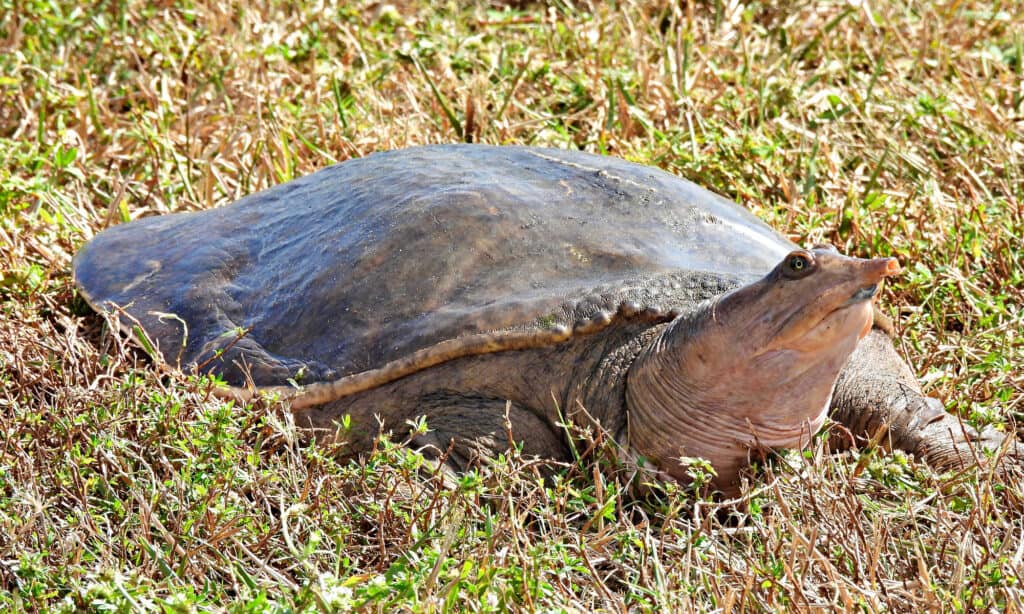
Florida softshell turtles are active hunters and are carnivorous
©iStock.com/passion4nature
The Florida Softshell Turtle: This reptile is capable of growing to 30 inches and is found in Alabama, Georgia, and South Carolina, as well as the entirety of Florida’s peninsula. Rather than a shell, it has a carapace formed from cartilage covered in skin. The Florida softshell turtle is mainly a carnivore and enjoys eating birds, fish, insects, and mollusks, in its preferred habitats which not only include swamps, but slow-moving rivers, streams, and wet prairies.
Summary 8 Snakes You’ll Find in the South’s Swamps
| Index | Species | Venomous/Nonvenomous | Location |
|---|---|---|---|
| 1 | Cottonmouth | Venomous | Throughout the South’s swamps |
| 2 | Green water snake | Nonvenomous | Florida, Georgia, and South Carolina |
| 3 | Red-bellied water snakes | Nonvenomous | Southern swamps |
| 4 | Black swamp snake | Nonvenomous | Coastal southeast, Florida panhandle |
| 5 | Banded water snake | Nonvenomous | Southern swamps |
| 6 | Crayfish snake | Nonvenomous | The coastal South including Texas and Virginia |
| 7 | Brown water snake | Nonvenomous | The coastal South, Florida panhandle |
| 8 | Burmese pythons | Nonvenomous | Florida Everglades |
The photo featured at the top of this post is © Mark_Kostich/Shutterstock.com
Discover the "Monster" Snake 5X Bigger than an Anaconda
Every day A-Z Animals sends out some of the most incredible facts in the world from our free newsletter. Want to discover the 10 most beautiful snakes in the world, a "snake island" where you're never more than 3 feet from danger, or a "monster" snake 5X larger than an anaconda? Then sign up right now and you'll start receiving our daily newsletter absolutely free.
Thank you for reading! Have some feedback for us? Contact the AZ Animals editorial team.







